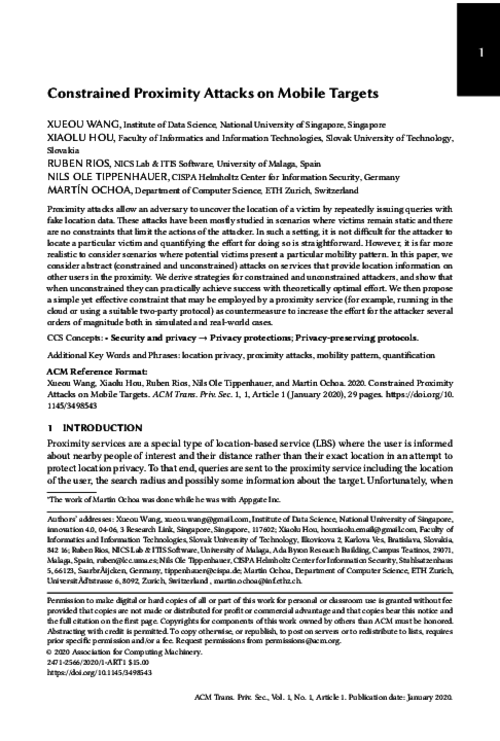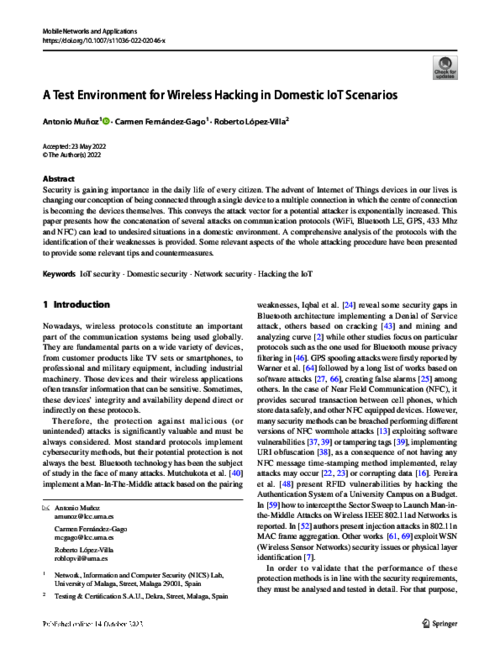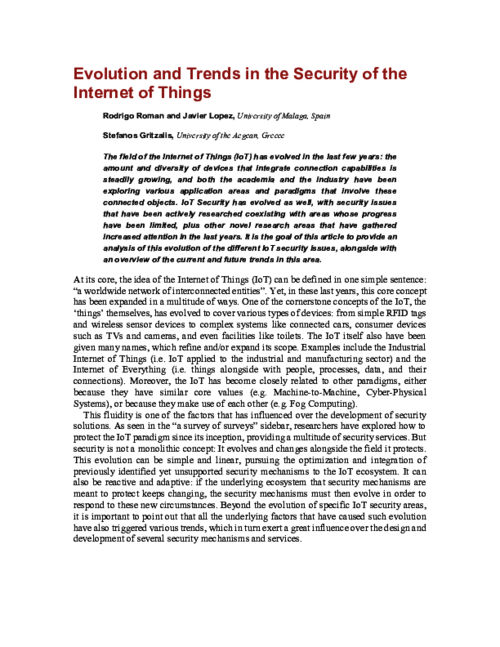 ] Title Type Year
] Title Type Year XIV Jornadas de Ingeniería Telemática (JITEL 2019), 10/2019.
Abstract
En los nuevos paradigmas de movilidad surgidos durante los últimos años y en aquellos aún por llegar ha quedado patente la necesidad de modernizar la infraestructura viaria y los elementos de señalización y gestión del tráfico. En el presente trabajo se presenta una propuesta para esta nueva generación de dispositivos de gestión del tráfico: un prototipo de semáforo inteligente conectado que implementa diversas medidas de seguridad. Además de las tradicionales señales luminosas, los usuarios de la vía pueden conocer a través de sus dispositivos el estado del semáforo, además de otra información complementaria a través de la difusión de mensajes BLE firmados con criptografía de curva elíptica. A su vez, el semáforo puede ser gestionado remotamente a través de la tecnología LTE Cat M1 protegida por TLS. Esto abre la puerta, entre otros, a facilitar el tránsito de los vehículos de emergencia cuando estos se acercan a un cruce o modificar el tiempo de los estados del ciclo en función de las necesidades del tráfico.
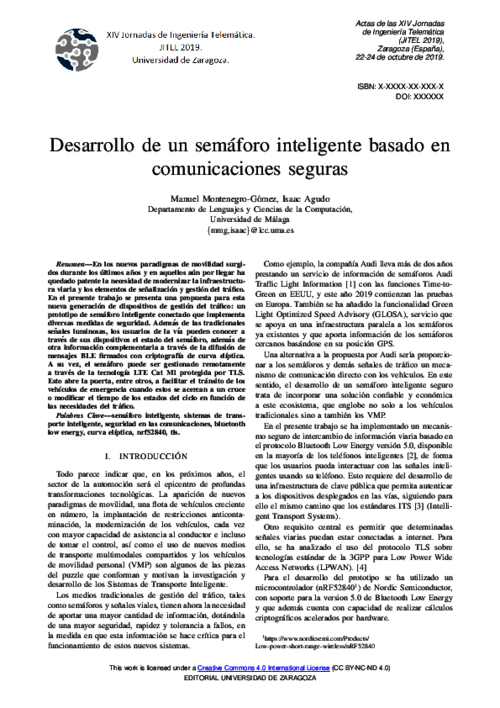
IEEE Transactions on Vehicular Technology, vol. 70, no. 5, IEEE, pp. 4001 - 4010, 05/2021. DOI
Abstract
New mobility paradigms have appeared in recent years, and everything suggests that some more are coming. This fact makes apparent the necessity of modernizing the road infrastructure, the signalling elements and the traffic management systems. Many initiatives have emerged around the term Intelligent Transport System (ITS) in order to define new scenarios and requirements for this kind of applications. We even have two main competing technologies for implementing Vehicular communication protocols (V2X), C-V2X and 802.11p, but neither of them is widely deployed yet.
One of the main barriers for the massive adoption of those technologies is governance. Current solutions rely on the use of a public key infrastructure that enables secure collaboration between the different entities in the V2X ecosystem, but given its global scope, managing such infrastructure requires reaching agreements between many parties, with conflicts of interest between automakers and telecommunication operators. As a result, there are plenty of use cases available and two mature communication technologies, but the complexity at the business layer is stopping the drivers from taking advantage of ITS applications.
Blockchain technologies are defining a new decentralized paradigm for most traditional applications, where smart contracts provide a straightforward mechanism for decentralized governance. In this work, we propose an approach for decentralized V2X (D-V2X) that does not require any trusted authority and can be implemented on top of any communication protocol. We also define a proof-of-concept technical architecture on top of a cheap and highly secure System-on-Chip (SoC) that could allow for massive adoption of D-V2X.
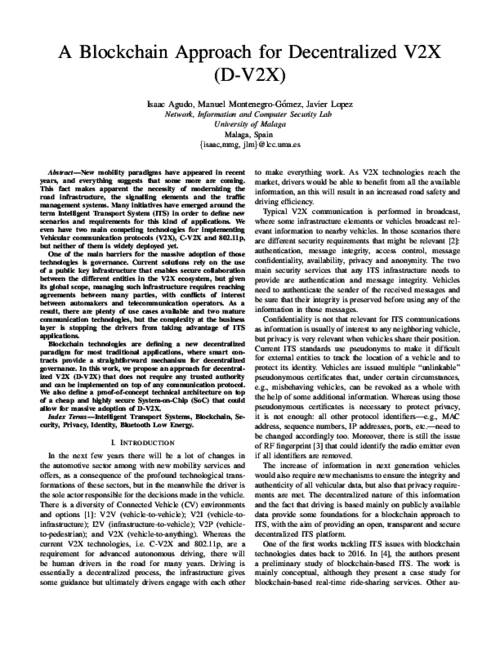
Ad Hoc Networks, vol. 11, Elsevier, pp. 1091–1104, 2013. DOI
Abstract
The main objective of remote substations is to provide the central system with sensitive information from critical infrastructures, such as generation, distribution or transmission power systems. Wireless sensor networks have been recently applied in this particular context due to their attractive services and inherent benefits, such as simplicity, reliability and cost savings. However, as the number of control and data acquisition systems that use the Internet infrastructure to connect to substations increases, it is necessary to consider what connectivity model the sensor infrastructure should follow: either completely isolated from the Internet or integrated with it as part of the Internet of Things paradigm. This paper therefore addresses this question by providing a thorough analysis of both security requirements and infrastructural requirements corresponding to all those TCP/IP integration strategies that can be applicable to networks with constrained computational resources.
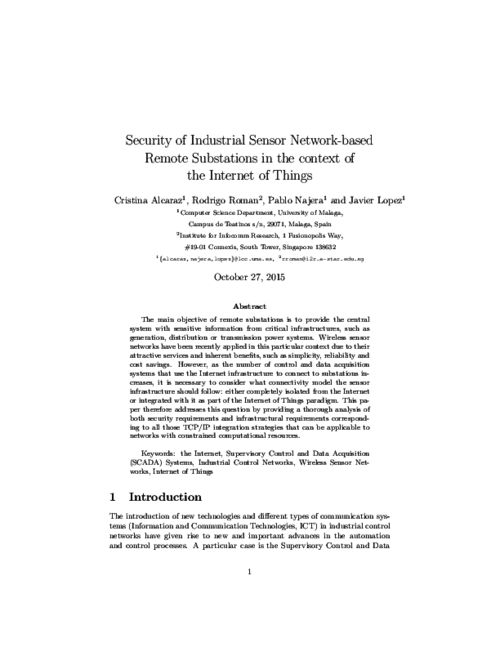
1st International Workshop on the Security of the Internet of Things (SecIoT’10), IEEE, pp. xxxx, December, 2010.
Abstract
Wireless sensor networks (WSN) behave as a digital skin, providing a virtual layer where the information about the physical world can be accessed by any computational system. As a result, they are an invaluable resource for realizing the vision of the Internet of Things (IoT). However, it is necessary to consider whether the devices of a WSN should be completely integrated into the Internet or not. In this paper, we tackle this question from the perspective of security. While we will mention the different security challenges that may arise in such integration process, we will focus on the issues that take place at the network level.
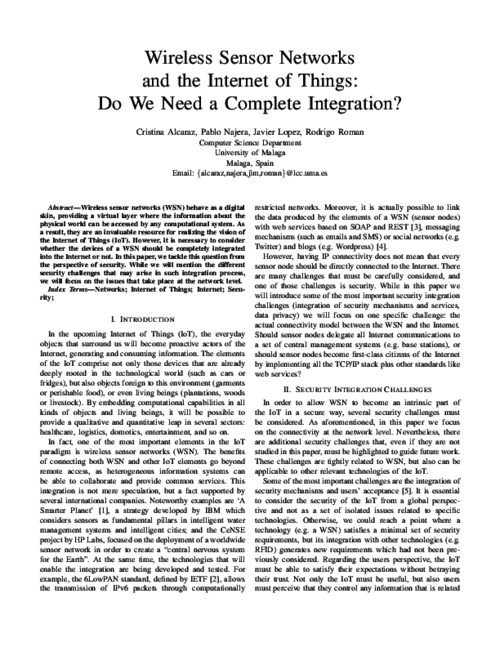
Proceedings of the First International Conference on Security of Internet of Things, ACM, pp. 172–178, 2012. DOI
Abstract
While there has been considerable progress in the research and technological development (RTD) of the Internet of Things (IoT), there is still considerable RTD required by international communities for the trust, privacy and security research challenges arising from the constitution of the IoT architectures, infrastructures, communications, devices, objects, applications and services. In this paper, we present an thorough analysis of the ongoing and future RTD work, specifically in Europe, regarding trust, privacy and security of the Internet of Things with a view towards enabling international cooperation efforts around the globe to solve these major research challenges.
Human-centric Computing and Information Sciences, vol. 10, no. 50, Springer, 12/2020. DOI
Abstract
The Internet of Things (IoT) is a paradigm that permits smart entities to be interconnected anywhere and anyhow. IoT opens new opportunities but also rises new issues.
In this dynamic environment, trust is useful to mitigate these issues. In fact, it is important that the smart entities could know and trust the other smart entities in order to collaborate with them.
So far, there is a lack of research when considering trust through the whole System Development Life Cycle (SDLC) of a smart IoT entity.
In this paper, we suggest a new approach that considers trust not only at the end of the SDLC but also at the start of it. More precisely, we explore the modeling phase proposing a model-driven approach extending UML and SysML considering trust and its related domains, such as security and privacy.
We propose stereotypes for each diagram in order to give developers a way to represent trust elements in an effective way.
Moreover, we propose two new diagrams that are very important for the IoT: a traceability diagram and a context diagram.
This model-driven approach will help developers to model the smart IoT entities according to the requirements elicited in the previous phases of the SDLC.
These models will be a fundamental input for the following and final phases of the SDLC.
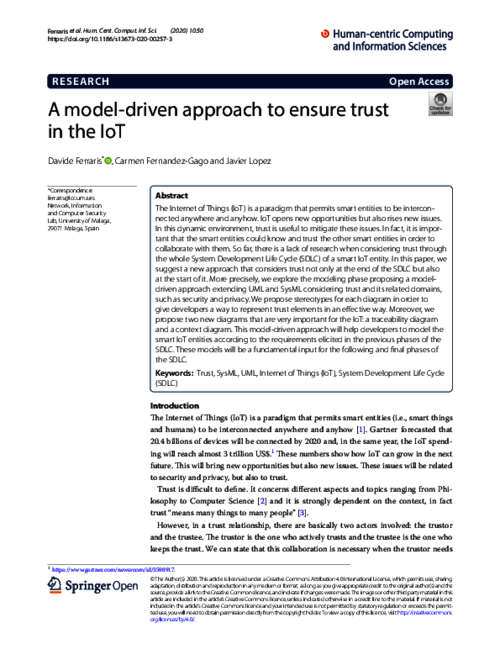
Collaborative Approaches for Cyber Security in Cyber-Physical Systems, no. Part of the Advanced Sciences and Technologies for Security Applications book series (ASTSA), Springer, pp. 145-170, 01/2023. DOI

International Journal of Information Security, Springer, 2020. DOI
Abstract
Nowadays, smart home devices like Amazon Echo and Google Home have reached mainstream popularity.
Being in the homes of users, these devices are intrinsically intrusive, being able to access details such as users' name, gender, home address, calendar appointments and others.
There are growing concerns about indiscriminate data collection and invasion of user privacy in smart home devices, but studies show that perceived benefits are exceeding perceived risks when it comes to consumers.
As a result, consumers are placing a lot of trust in these devices, sometimes without realizing it.
Improper trust assumptions and security controls can lead to unauthorized access and control of the devices, which can result in serious consequences.
In this paper, we explore the behaviour of devices such as Amazon Echo and Google Home in a smart home setting with respect to trust relationships and propose a trust model to improve these relationships among all the involved actors.
We have evaluated how trust was built and managed from the initial set up phase to the normal operation phase, during which we performed a number of interaction tests with different types of users (i.e. owner, guests).
As a result, we were able to assess the effectiveness of the provided security controls and identify potential relevant security issues. In order to address the identified issues, we defined a trust model and propose a solution based on it for further securing smart home systems.
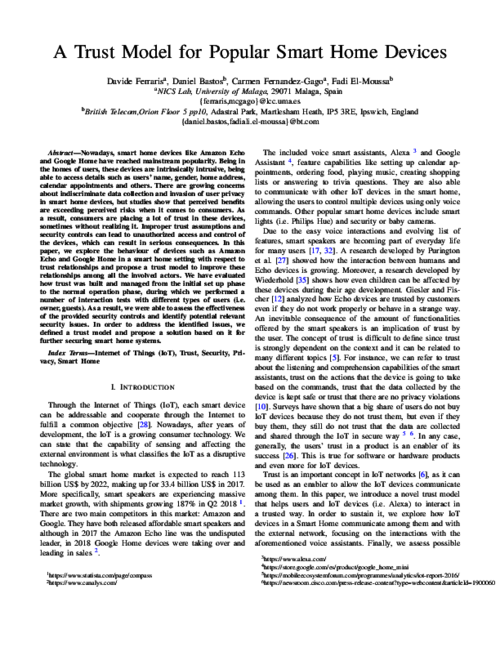
IEEE Consumer Communications & Networking Conference 2019, IEEE, 03/2019. DOI
Abstract
With the ever-increasing number of smart home devices, the issues related to these environments are also growing. With an ever-growing attack surface, there is no standard way to protect homes and their inhabitants from new threats. The inhabitants are rarely aware of the increased security threats that they are exposed to and how to manage them. To tackle this problem, we propose a solution based on segmented architectures similar to the ones used in industrial systems. In this approach, the smart home is segmented into various levels, which can broadly be categorised into an inner level and external level. The external level is protected by a firewall that checks the communication from/to the Internet to/from the external devices. The internal level is protected by an additional firewall that filters the information and the communications between the external and the internal devices. This segmentation guarantees a trusted environment between the entities belonging to the internal network. In this paper, we propose an adaptive trust model that checks the behaviour of the entities and, through this model, in case the entities violate trust rules they can be put in quarantine or banned from the network.
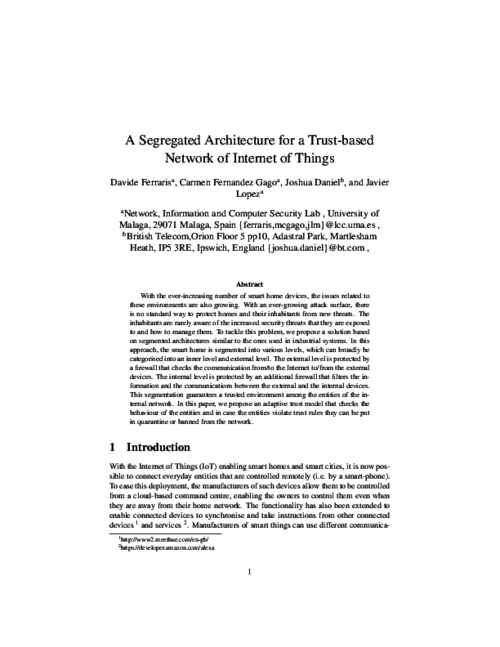
2018 9th IFIP International Conference on New Technologies Mobility and Security (NTMS), IEEE, 04/2018. DOI
Abstract
The Internet of Things (IoT) is an environment of interconnected entities, that are identifiable, usable and controllable via the Internet. Trust is necessary in a system such as IoT as the entities involved should know the effect of interacting with other entities. Moreover, the entities must also be able to trust a system to reliably use it. An IoT system is composed of different entities from different vendors, each of them with a different purpose and a different lifecycle. So considering trust in the whole IoT system lifecycle is useful and necessary to guarantee a good service for the whole system. The heterogeneity and dynamicity of this field make it difficult to ensure trust in IoT. We propose a trust by design framework for including trust in the development of an IoT entity considering all the phases of the life-cycle. It is composed of the K-Model and transversal activities.
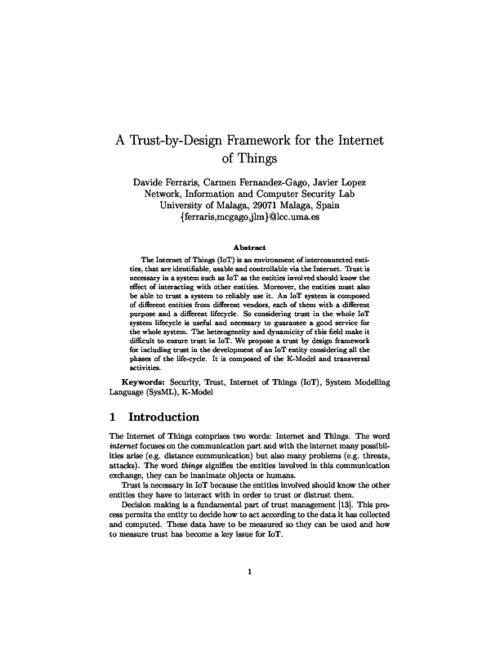
The 20th World Conference on Information Security Applications: WISA-Workshop 2019, Springer, 2019.
Abstract
In recent times, smart home devices like Amazon Echo and Google Home have reached mainstream popularity. These devices are intrinsically intrusive, being able to access user’s personal information. There are growing concerns about indiscriminate data collection and invasion of user privacy in smart home devices. Improper trust assumptions and security controls can lead to unauthorized access of the devices, which can have severe consequences (i.e. safety risks). In this paper, we analysed the behaviour of smart home devices with respect to trust relationships. We set up a smart home environment to evaluate how trust is built and managed. Then, we performed a number of interaction tests with different types of users (i.e. owner, guests). As a result, we were able to assess the effectiveness of the provided security controls and identify some relevant security issues. To address them, we defined a trust model and proposed a solution based on it for securing smart home devices.

36th Annual IFIP WG 11.3 Conference on Data and Applications Security and Privacy (DBSec'22), vol. 13383, Springer, pp. 183-194, 07/2022. DOI
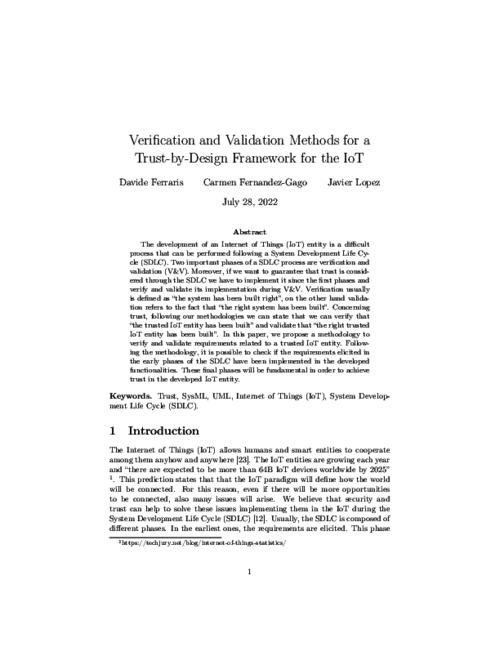
International Journal of Information Security , Springer, pp. 111-127, 01/2020, 2019. DOI
Abstract
The Internet of Things (IoT) is an environment of interconnected entities, which are identifiable, usable and controllable via the Internet. Trust is useful for a system such as the IoT as the entities involved would like to know how the other entities they have to interact with are going to perform.
When developing an IoT entity, it will be desirable to guarantee trust during its whole life cycle. Trust domain is strongly dependent on other domains such as security and privacy.
To consider these domains as a whole and to elicit the right requirements since the first phases of the System Development Life Cycle (SDLC) is a key point when developing an IoT entity.
This paper presents a requirements elicitation method focusing on trust plus other domains such as security, privacy and usability that increase the trust level of the IoT entity developed. To help the developers to elicit the requirements, we propose a JavaScript Notation Object (JSON) template containing all the key elements that must be taken into consideration.
We emphasize on the importance of the concept of traceability. This property permits to connect all the elicited requirements guaranteeing more control on the whole requirements engineering process.
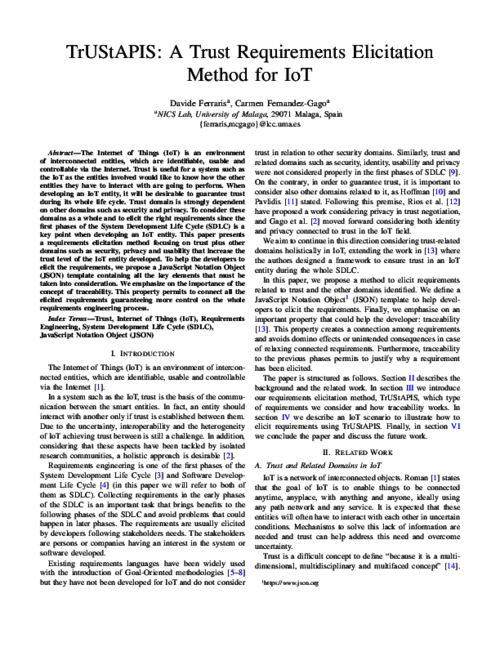
37th International Conference on ICT Systems Security and Privacy Protection – IFIP SEC 2022, Springer, pp. 215-230, 06/2022. DOI
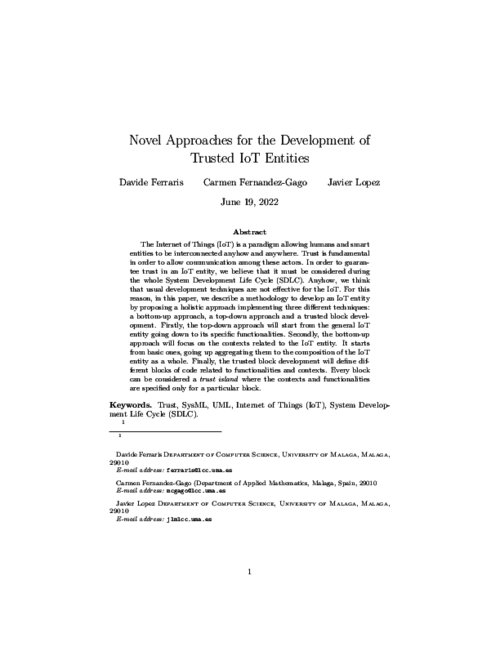
Revista SIC, vol. 88, Ediciones CODA, pp. 66-73, Feb 2010.
Abstract
El paradigma de la Internet de los Objetos, donde todos aquellos objetos físicos que nos rodean tendrán la capacidad de generar y consumir información en el ámbito de un mundo virtual, se encuentra cada vez más cerca. Es ahora un buen momento para llamar la atención sobre sus principales desafíos de seguridad, tanto desde un punto de vista global como asociados a sus elementos más importantes (la tecnología RFID y las redes de sensores). Así, este paradigma puede ser plenamente comprendido y protegido, evolucionando hacia uno de los nuevos pilares del futuro.
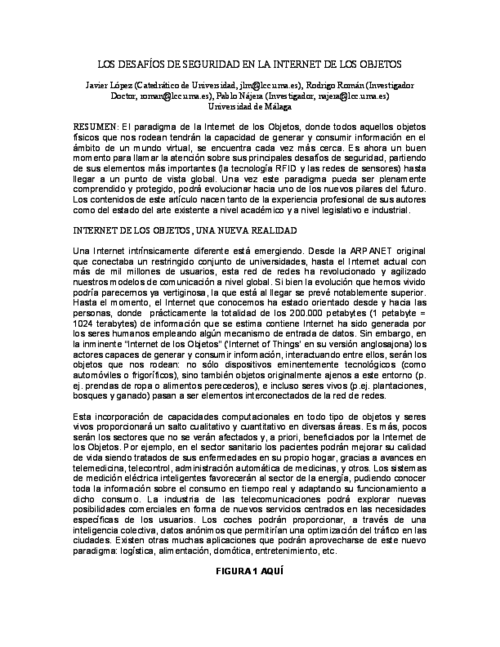
Future Generation Computer Systems, vol. 75, Elsevier, pp. 46–57, 10/2017. DOI
Abstract
The Internet of Things (IoT) envisions a world covered with billions of smart, interacting things capable of offering all sorts of services to near and remote entities. The benefits and comfort that the IoT will bring about are undeniable, however, these may come at the cost of an unprecedented loss of privacy. In this paper we look at the privacy problems of one of the key enablers of the IoT, namely wireless sensor networks, and analyse how these problems may evolve with the development of this complex paradigm. We also identify further challenges which are not directly associated with already existing privacy risks but will certainly have a major impact in our lives if not taken into serious consideration.
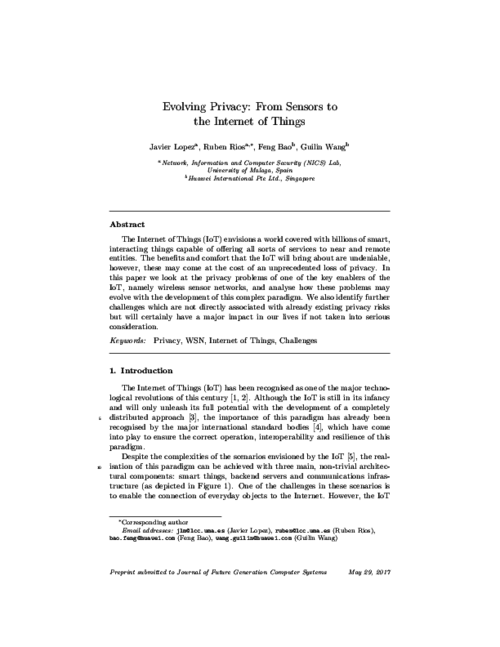
19th International Conference on Security and Cryptography (SECRYPT 2022), Scitepress, pp. 249-260, 07/2022. DOI
Abstract
Crowd Counting is a very interesting problem aiming at counting people typically based on density averages and/or aerial images. This is very useful to prevent crowd crushes, especially on urban environments with high crowd density, or to count people in public demonstrations. In addition, in the last years, it has become of paramount importance for pandemic management. For those reasons, giving users automatic mechanisms to anticipate high risk situations is essential. In this work, we analyze ID-based Crowd Counting, and propose a real-time Crowd Counting system based on the Ephemeral ID broadcast by contact tracing applications on wearable devices. We also performed some simulations that show the accuracy of our system in different situations.
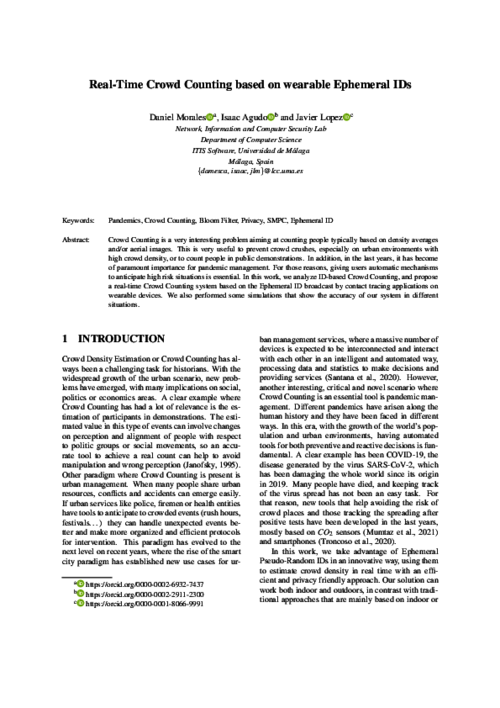
Mobile Networks and Applications, Springer, 2022/10/14. DOI
Security and Communication Networks, vol. 6, Wiley-Blackwell, pp. 1177–1197, Oct 2013. DOI
Abstract
A personal network (PN) should enable the collaboration of user’s devices and services in a flexible, self-organizing and friendly manner. For such purpose, the PN must securely accommodate heterogeneous technologies with uneven computational and communication resources. In particular, personal RFID tags can enable seamless recognition of user’s context, provide user authentication and enable novel services enhancing the quality and quantity of data handled by the PN. However, the highly constrained features of common RFID tags and their passive role in the network highlights the need of an adequate secure communication model with personal tags which enables their participation as a member of the PN. In this paper, we present our concept of PN, with special emphasis on the role of RFID and sensor networks, and define a secure architecture for PNs including methods for the secure access to context-aware technologies from both local PN members and the Internet of Things. The PN architecture is designed to support differentiated security mechanisms to maximize the level of security for each type of personal device. Furthermore, we analyze which security solutions available in the literature can be adapted for our architecture, as well as the challenges and security mechanisms still necessary in the secure integration of personal tags.
Mobile Networks and Applications (MONET) Journal, vol. 19, issue 1, Springer US, pp. 64-78, 02/2014. DOI
Abstract
Today, mobile platforms are multimedia devices that provide different types of traffic with the consequent particular performance demands and, besides, security concerns (e.g. privacy). However, Security and QoS requirements quite often conflict to a large degree; the mobility and heterogeneous paradigm of the Future Internet makes coexistence even more difficult, posing new challenges to overcome. Probably, one of the main challenges is to identify the specific reasons why Security and QoS mechanisms are so related to each other. In this paper, we present a Parametric Relationship Model (PRM) to identify the Security and QoS dependencies, and to elaborate on the Security and QoS tradeoff. In particular, we perform an analysis that focus on the mobile platform environment and, consequently, also considers subjective parameters such user’s experience, that is crucial for increasing the usability of new solutions in the Future Internet. The final aim of our contribution is to facilitate the development of secure and efficient services for mobile platforms.
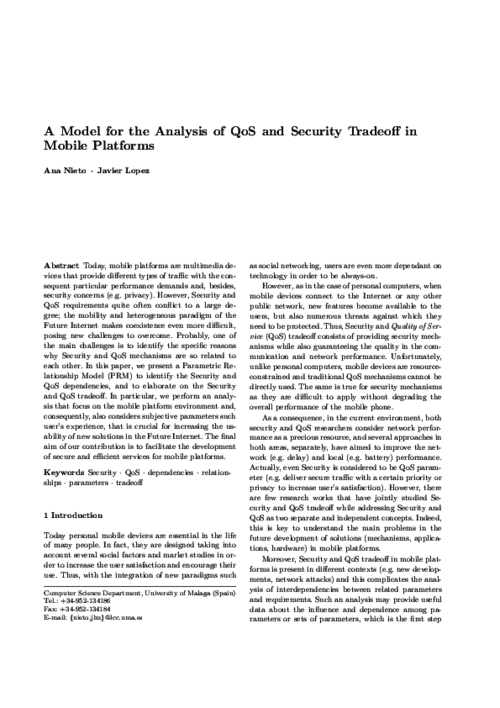
9th International Conference on Risk and Security of Internet and Systems (CRiSIS'14), vol. 8924, Springer, pp. 52-66, 2014. DOI
Abstract
Context-based Parametric Relationship Models (CPRMs) reduce the complexity of working with various numbers of parameters and dependencies, by adding particular contexts to the final scheme when it is required, dynamically. In this paper the cost of including new information in CPRM is properly analysed, considering the information in the parametric trees defined for the parameters in the CPRM-based system. Some strategies for mitigating the cost of the instantiation process are proposed.
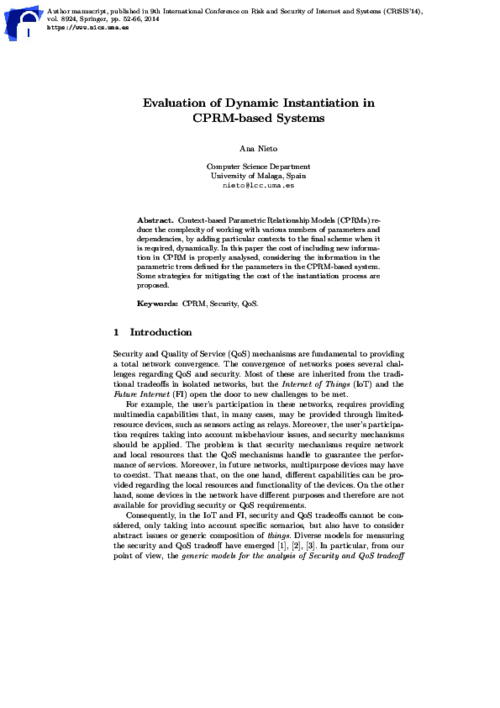
10th ACM International Symposium on QoS and Security for Wireless and Mobile Networks (Q2SWinet'14), ACM, pp. 25-32, 09/2014. DOI
Abstract
Context-based Parametric Relationship Models (CPRM) define complex dependencies between different types of parameters. In particular, Security and QoS relationships, that may occur at different levels of abstraction, are easily identified using CPRM. However, the growing number of parameters and relationships, typically due to the heterogeneous scenarios of future networks, increase the complexity of the final diagrams used in the analysis, and makes the current solution for assessing Security and QoS tradeoff (SQT) impractical for untrained users. In this paper, we define a recommendation system based on contextual parametric relationships in accordance with the definition of CPRM. The inputs for the system are generated dynamically based on the context provided by CPRM-based systems.
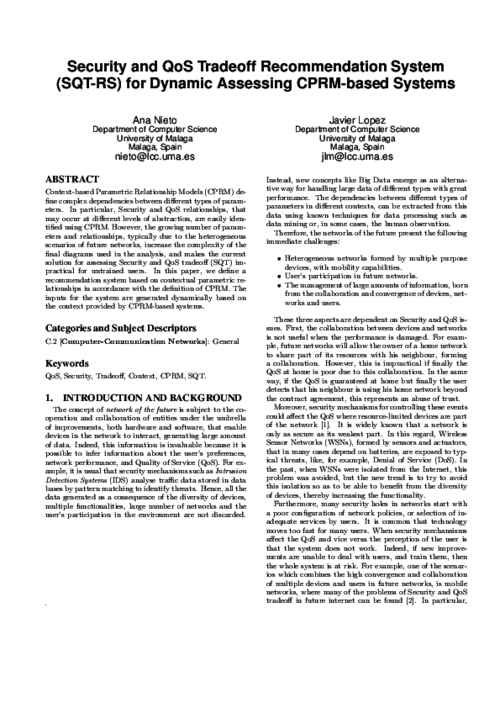
XIII Reunión Española sobre Criptología y Seguridad de la Información (RECSI 2014), pp. 303-308, 09/2014.
Abstract
El análisis conjunto de mecanismos de seguridad y QoS es esencial para las redes heterogéneas donde diversos dispositivos pueden coexistir en entornos dinámicos. En concreto, los dispositivos no siempre pueden ser conocidos, por lo que diferentes requisitos y mecanismos pueden surgir para el análisis. En este artículo, proponemos una herramienta para facilitar la configuración de entornos basada en el análisis paramétrico de dependencias, tomando como base de conocimiento un conjunto de parámetros de seguridad y QoS. Esta forma de análisis de parámetros a alto nivel permite considerar las dependencias y la compensación entre mecanismos con independencia del sistema de información subyacente. Posibilita por tanto evaluar el impacto que tales mecanismos, y otros definidos acorde al modelo, tienen sobre un sistema previo a su despliegue.
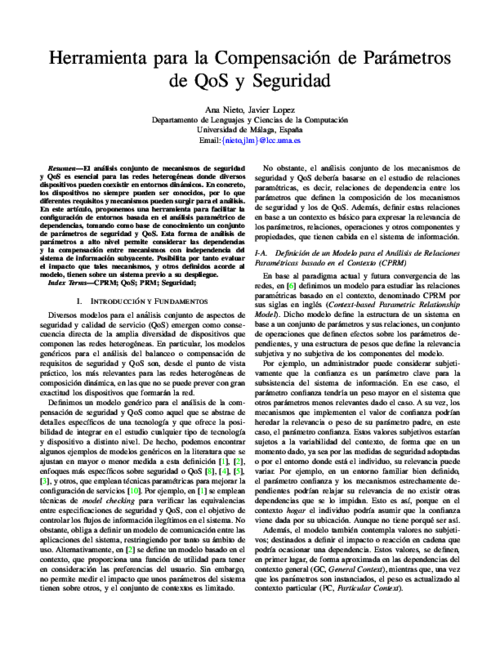
IEEE International Conference on Communications (ICC'14), IEEE Communications Society, pp. 755-760, 06/2014. DOI
Abstract
Heterogeneity of future networks requires the use of extensible models to understand the Security and QoS tradeoff. We believe that a good starting point is to analyze the Security and QoS tradeoff from a parametric point of view and, for this reason, in a previous paper, we defined the Parametric Rela- tionship Model (PRM) to define relationships between Security and QoS parameters. In this paper, we extend that approach in order to change the behaviour of the model so that different contexts in the same system are considered; that is, to provide a Context-based Parametric Relationship Model (CPRM). The final aim is to provide useful tools for system administrators in order to help them deal with Security and QoS tradeoff issues in the configuration of the environment.
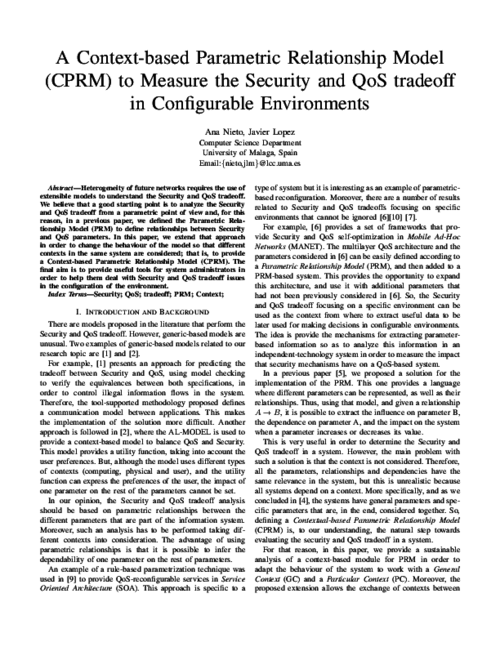
31st Annual IFIP WG 11.3 Conference on Data and Applications Security and Privacy (DBSec'17), vol. LNCS 10359, Springer, pp. 453-472, 07/2017. DOI
Abstract
In this paper, we analyze how key compromise affects the protocol by Nguyen et al. presented at ESORICS 2016, an authenticated key agreement protocol mediated by a proxy entity, restricted to only symmetric encryption primitives and intended for IoT environments. This protocol uses long-term encryption tokens as intermediate values during encryption and decryption procedures, which implies that these can be used to encrypt and decrypt messages without knowing the cor- responding secret keys. In our work, we show how key compromise (or even compromise of encryption tokens) allows to break forward secu- rity and leads to key compromise impersonation attacks. Moreover, we demonstrate that these problems cannot be solved even if the affected user revokes his compromised secret key and updates it to a new one. The conclusion is that this protocol cannot be used in IoT environments, where key compromise is a realistic risk.
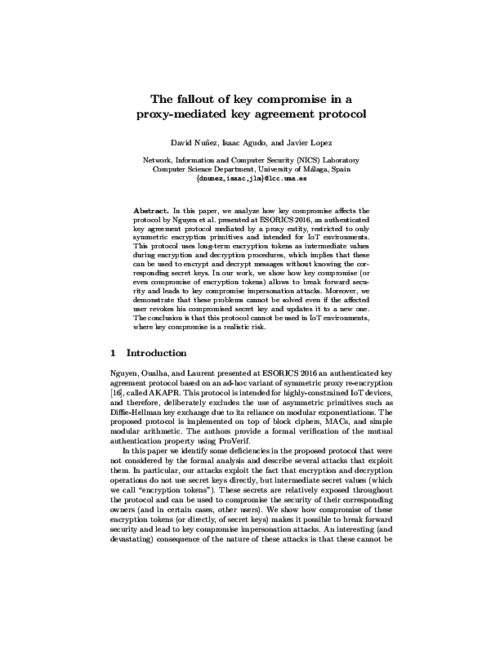
IEEE Internet of Things Journal, vol. 6, issue 5, IEEE Computer Society, pp. 8038-8045, 10/2019. DOI
Abstract
Edge Computing paradigms are expected to solve some major problems affecting current application scenarios that rely on Cloud computing resources to operate. These novel paradigms will bring computational resources closer to the users and by doing so they will not only reduce network latency and bandwidth utilization but will also introduce some attractive context-awareness features to these systems. In this paper we show how the enticing features introduced by Edge Computing paradigms can be exploited to improve security and privacy in the critical scenario of vehicular networks (VN), especially existing authentication and revocation issues. In particular, we analyze the security challenges in VN and describe three deployment models for vehicular edge computing, which refrain from using vehicular- to-vehicular communications. The result is that the burden imposed to vehicles is considerably reduced without sacrificing the security or functional features expected in vehicular scenarios.
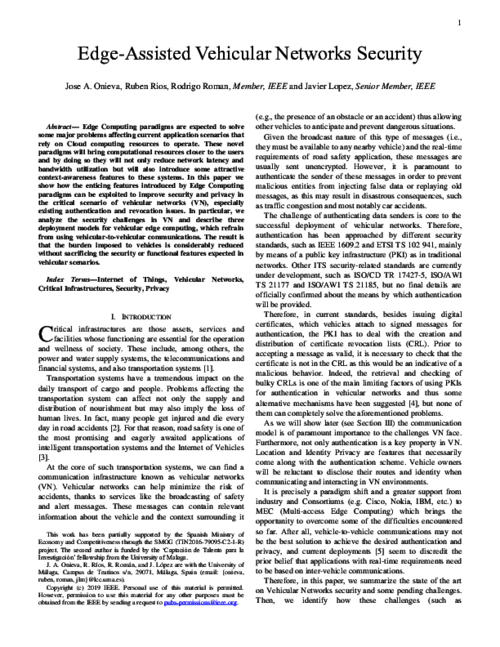
2nd IEEE International Conference on Fog and Edge Mobile Computing (FMEC 2017), IEEE Computer Society, pp. 56-61, 06/2017. DOI
Abstract
Cloud computing has some major limitations that hinder its application to some specific scenarios (e.g., Industrial IoT, and remote surgery) where there are particularly stringent requirements, such as extremely low latency. Fog computing is a specialization of the Cloud that promises to overcome the aforementioned limitations by bringing the Cloud closer to end-users. Despite its potential benefits, Fog Computing is still a developing paradigm which demands further research, especially on security and privacy aspects. This is precisely the focus of this paper: to make evident the urgent need for security mechanisms in Fog computing, as well as to present a research strategy with the necessary steps and processes that are being undertaken within the scope of the SMOG project, in order to enable a trustworthy and resilient Fog ecosystem.
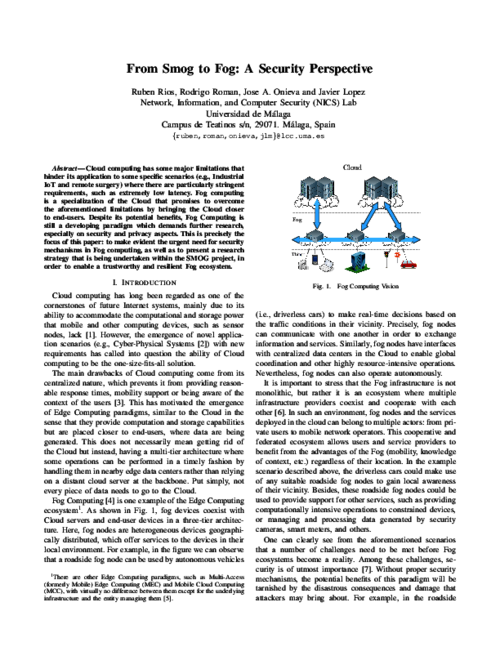
32nd International Conference on ICT Systems Security and Privacy Protection (IFIP SEC 2017), S. De Capitan di Vimercati, and F. Martinelli Eds., IFIP Advances in Information and Communication Technology (AICT) 502, Springer, pp. 141–154, 05/2017. DOI
Abstract
The Internet of Things (IoT) promises to revolutionize the way we interact with the physical world. Even though this paradigm is still far from being completely realized, there already exist Sensing-as-a-Service (S2aaS) platforms that allow users to query for IoT data. While this model offers tremendous benefits, it also entails increasingly challenging privacy issues. In this paper, we concentrate on the protection of user privacy when querying sensing devices through a semi-trusted S2aaS platform. In particular, we build on techniques inspired by proxy re-encryption and k-anonymity to tackle two intertwined problems, namely query privacy and query confidentiality. The feasibility of our solution is validated both analytically and empirically.
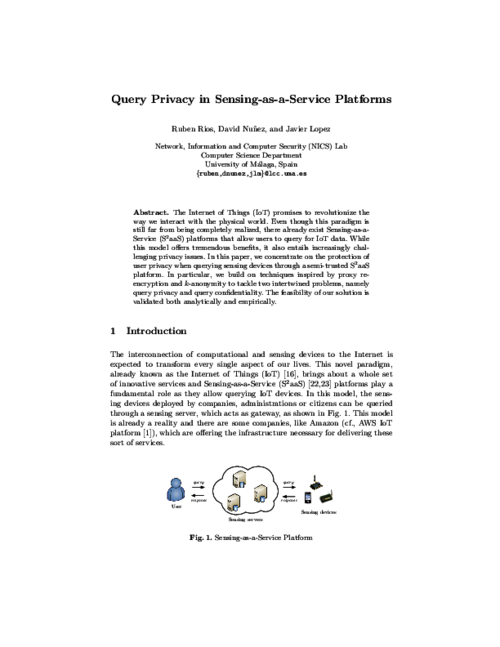
IEEE Security & Privacy , vol. 20, issue 1, IEEE, pp. 23 - 32, 01/2022. DOI
Abstract
This article introduces a privacy manager for IoT data based on Edge Computing. This poses the advantage that privacy is enforced before data leaves the control of the user, who is provided with a tool to express data sharing preferences based on a novel context-aware privacy language.
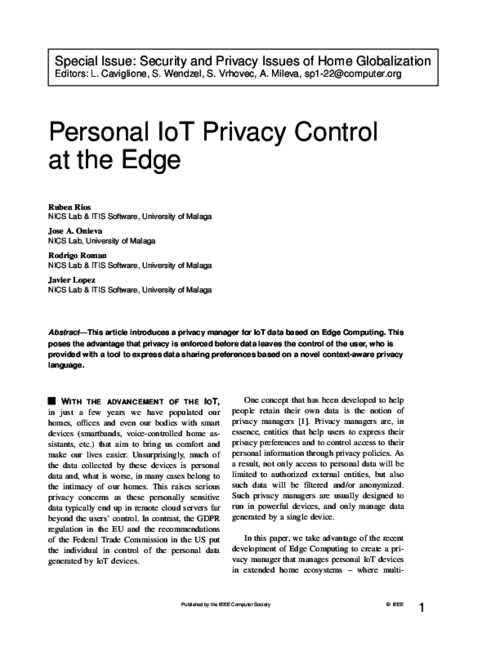
XIV Reunión Española sobre Criptología y Seguridad de la Información, pp. 209-213, 10/2016.
Abstract
La Internet de las Cosas (en inglés, Internet of Things (IoT)) es una evolución de la Internet tal y como lo conocemos. Esta nueva versión de Internet incorpora objetos de la vida cotidiana, rompiendo así barrera de los digital y extendiéndose al mundo físico. Estos objetos interactuarán entre sí y con otras entidades tanto de manera local como remota, y estarán dotados de cierta capacidad computacional y sensores para que sean conscientes de lo que ocurre en su entorno. Esto traerá consigo un sinfín de posibilidades y nuevos servicios, pero también dará lugar a nuevos y mayores riesgos de privacidad para los ciudadanos. En este artículo, estudiamos los problemas de privacidad actuales de una de las tecnologías claves para el desarrollo de este prometedor paradigma, las redes de sensores, y analizamos como pueden evolucionar y surgir nuevos riesgos de privacidad al ser completamente integradas en la Internet.

3rd CompanionAble Workshop - Future Internet of People, Things and Services (IoPTS) eco-Systems, xxxx, pp. xxxx, December, 2009.
Abstract
Wireless sensor networks are considered as an integral part of the Internet of Things paradigm. Not only they provide a virtual presence to elements of the real world, but also allow any computationalsystem to know about the physical state of those elements thanks to the use of embedded sensors. In order to belong to the Internet of Things, the elements of a sensor network can implement Internet protocols and services such as the TCP/IP stack and web services. Still, a question that must be raised at this point of time is whether all sensor network applications should be completely integrated into the Internet or not. The purpose of this paper is to analyze this question, reviewing the challenges and security requirements of Internet-enabled sensor networks.

IEEE Computer, vol. 44, no. 9, IEEE, pp. 51 -58, Sept 2011. DOI
Abstract
This paper presents security of Internet of things. In the Internet of Things vision, every physical object has a virtual component that can produce and consume services Such extreme interconnection will bring unprecedented convenience and economy, but it will also require novel approaches to ensure its safe and ethical use. The Internet and its users are already under continual attack, and a growing economy-replete with business models that undermine the Internet’s ethical use-is fully focused on exploiting the current version’s foundational weaknesses.
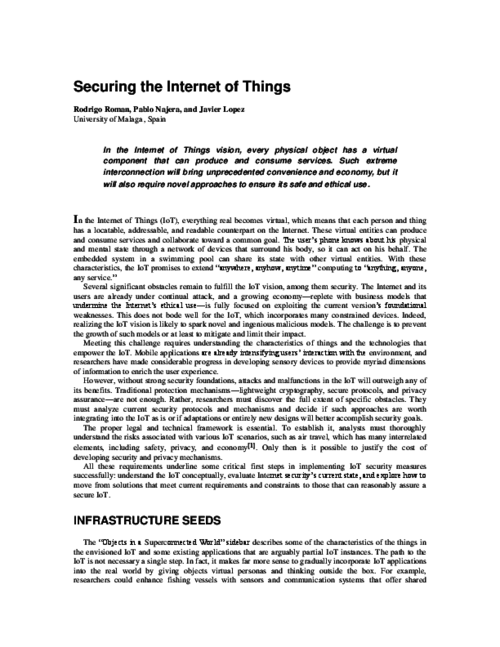
IEEE Computer, vol. 51, issue 7, IEEE Computer Society, pp. 16-25, 07/2018. DOI
Internet Research, vol. 19, no. 2, Emerald, pp. 246-259, Mar 2009. DOI
Abstract
Purpose: This paper aims to analyze the security issues that arise when integrating wireless sensor networks (WSN) and the internet. Also, it seeks to review whether existing technology mechanisms are suitable and can be applied in this context.
Design/methodology/approach: The paper considers the possible approaches that can be used to connect a WSN with the internet, and analyzes the security of their interactions.
Findings: By providing the services of the network through a front-end proxy, a sensor network and the internet can interact securely. There are other challenges to be solved if the sensor nodes are integrated into the internet infrastructure, although there exists interesting advances on his matter.
Research limitations and implications: The complete integration of sensor networks and the internet still remains as an open issue.
Practical implications: With the current state of the art, it is possible to develop a secure sensor network that can provide its services to internet hosts with certain security properties.
Originality/value: The paper studies the interactions between sensor networks and the internet from the point of view of security. It identifies both solutions and research challenges.
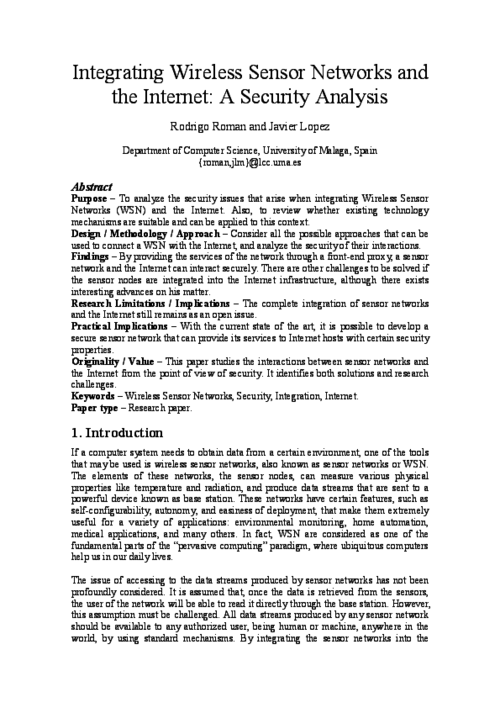
Computer Networks, vol. 57, Elsevier, pp. 2266–2279, July 2013. DOI
Abstract
In the Internet of Things, services can be provisioned using centralized architectures, where central entities acquire, process, and provide information. Alternatively, distributed architectures, where entities at the edge of the network exchange information and collaborate with each other in a dynamic way, can also be used. In order to understand the applicability and viability of this distributed approach, it is necessary to know its advantages and disadvantages – not only in terms of features but also in terms of security and privacy challenges. The purpose of this paper is to show that the distributed approach has various challenges that need to be solved, but also various interesting properties and strengths.
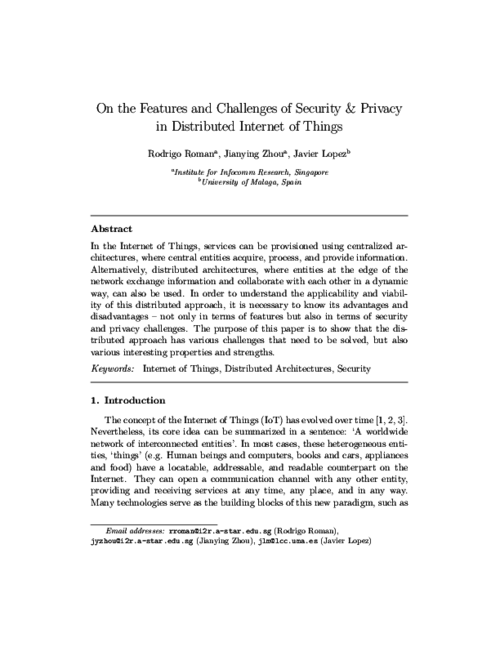
Future Generation Computer Systems, vol. 78, issue 1, Elsevier, pp. 680-698, 01/2018. DOI
Abstract
For various reasons, the cloud computing paradigm is unable to meet certain requirements (e.g. low latency and jitter, context awareness, mobility support) that are crucial for several applications (e.g. vehicular networks, augmented reality). To fulfil these requirements, various paradigms, such as fog computing, mobile edge computing, and mobile cloud computing, have emerged in recent years. While these edge paradigms share several features, most of the existing research is compartmentalised; no synergies have been explored. This is especially true in the field of security, where most analyses focus only on one edge paradigm, while ignoring the others. The main goal of this study is to holistically analyse the security threats, challenges, and mechanisms inherent in all edge paradigms, while highlighting potential synergies and venues of collaboration. In our results, we will show that all edge paradigms should consider the advances in other paradigms.

IEEE Internet of Things Journal, vol. 6, issue 3, IEEE Computer Society, pp. 4774-4781, 06/2019. DOI
Abstract
The Internet of Things (IoT) and Edge Computing are starting to go hand in hand. By providing cloud services close to end-users, edge paradigms enhance the functionality of IoT deployments, and facilitate the creation of novel services such as augmented systems. Furthermore, the very nature of these paradigms also enables the creation of a proactive defense architecture, an immune system, which allows authorized immune cells (e.g., virtual machines) to traverse edge nodes and analyze the security and consistency of the underlying IoT infrastructure. In this article, we analyze the requirements for the development of an immune system for the IoT, and propose a security architecture that satisfies these requirements. We also describe how such a system can be instantiated in Edge Computing infrastructures using existing technologies. Finally, we explore the potential application of immune systems to other scenarios and purposes.
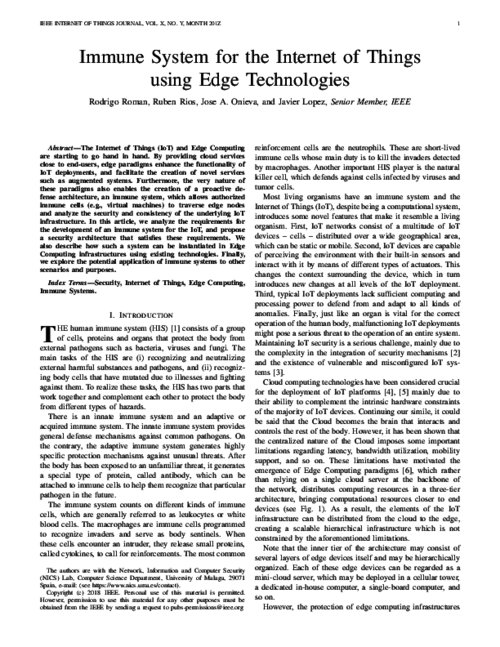
Computers & Electrical Engineering, vol. 37, Elsevier, pp. 147-159, Mar 2011. DOI
Abstract
If a wireless sensor network (WSN) is to be completely integrated into the Internet as part of the Internet of Things (IoT), it is necessary to consider various security challenges, such as the creation of a secure channel between an Internet host and a sensor node. In order to create such a channel, it is necessary to provide key management mechanisms that allow two remote devices to negotiate certain security credentials (e.g. secret keys) that will be used to protect the information flow. In this paper we will analyse not only the applicability of existing mechanisms such as public key cryptography and pre-shared keys for sensor nodes in the IoT context, but also the applicability of those link-layer oriented key management systems (KMS) whose original purpose is to provide shared keys for sensor nodes belonging to the same WSN.
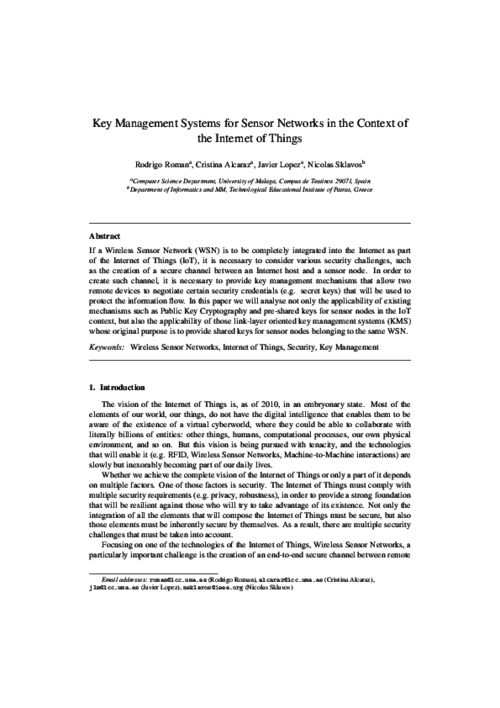
IEEE Transactions on Industrial Informatics, vol. 16, issue 10, no. 6575-6583, IEEE, 10/2020. DOI
Abstract
In Industrial Internet of Things (IIoT) scenarios, where a plethora of IoT technologies coexist with consolidated industrial infrastructures, the integration of security mechanisms that provide protection against cyber-security attacks becomes a critical challenge. Due to the stealthy and persistent nature of some of these attacks, such as Advanced Persistent Threats, it is crucial to go beyond traditional Intrusion Detection Systems for the traceability of these attacks. In this sense, Opinion Dynamics poses a novel approach for the correlation of anomalies, which has been successfully applied to other network security domains. In this paper, we aim to analyze its applicability in the IIoT from a technical point of view, by studying its deployment over different IIoT architectures and defining a common framework for the acquisition of data considering the computational constraints involved. The result is a beneficial insight that demonstrates the feasibility of this approach when applied to upcoming IIoT infrastructures.
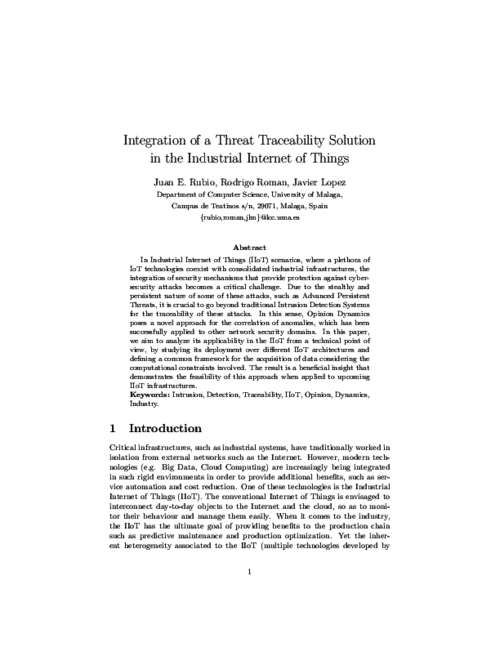
VII Jornadas Nacionales de Investigación en Ciberseguridad (JNIC 2022), pp. 122-129, 06/2022.
Abstract
La privacidad contextual se refiere a la protección de toda aquella información que puede desprenderse de la interacción entre usuarios y/o servicios, exceptuando los datos que el propio usuario elige transmitir. La localización, el tiempo, los patrones de uso y los diferentes parámetros necesarios para realizar la comunicación son algunos ejemplos. Este tipo de privacidad es extremadamente importante en la computación edge debido al acercamiento de los recursos de la infraestructura a los usuarios. Por ello, el objetivo de este trabajo es ofrecer un análisis y clasificación de las diferentes soluciones propuestas en la literatura respecto a la privacidad contextual en entornos edge, mostrando tanto las capacidades de los mecanismos actuales como los desafíos en este campo.
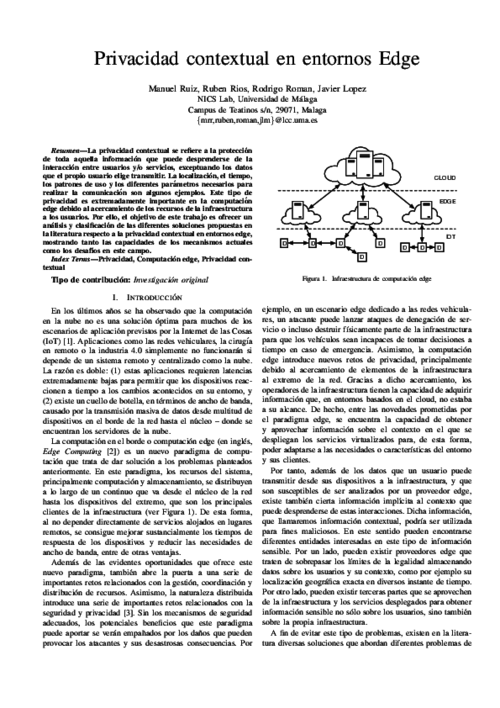
KSII Transactions on Internet and Information Systems, vol. 12, no. 8, KSII, pp. 3567-3588, 08/2018. DOI
Abstract
In the Internet of Things (IoT) concept, devices communicate autonomously with applications in the Internet. A significant aspect of IoT that makes it stand apart from present-day networked devices and applications is a) the very large number of devices, produced by diverse makers and used by an even more diverse group of users; b) the applications residing and functioning in what were very private sanctums of life e.g. the car, home, and the people themselves. Since these diverse devices require high-level security, an operational model for an IoT system is required, which has built-in security. We have proposed the societal model as a simple operational model. The basic concept of the model is borrowed from human society – there will be infants, the weak and the handicapped who need to be protected by guardians. This natural security mechanism works very well for IoT networks which seem to have inherently weak security mechanisms. In this paper, we discuss the requirements of the societal model and examine its feasibility by doing a proof-of-concept implementation.
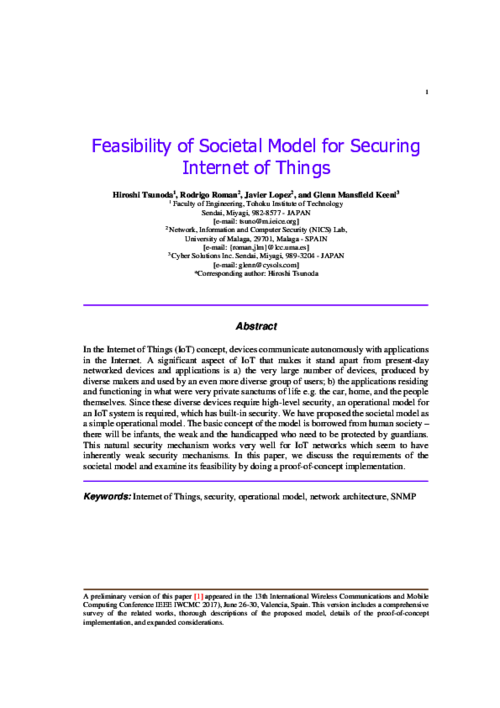
23rd European Symposium on Research in Computer Security (ESORICS 2018), LNCS 11099, Springer, pp. 373-392, 2018. DOI
Abstract
Location privacy has mostly focused on scenarios where users remain static. However, investigating scenarios where the victims present a particular mobility pattern is more realistic. In this paper, we consider abstract attacks on services that provide location information on other users in the proximity. In that setting, we quantify the required effort of the attacker to localize a particular mobile victim. We prove upper and lower bounds for the effort of an optimal attacker. We experimentally show that a Linear Jump Strategy (LJS) practically achieves the upper bounds for almost uniform initial distributions of victims. To improve performance for less uniform distributions known to the attacker, we propose a Greedy Updating Attack Strategy (GUAS). Finally, we derive a realistic mobility model from a real-world dataset and discuss the performance of our strategies in that setting.
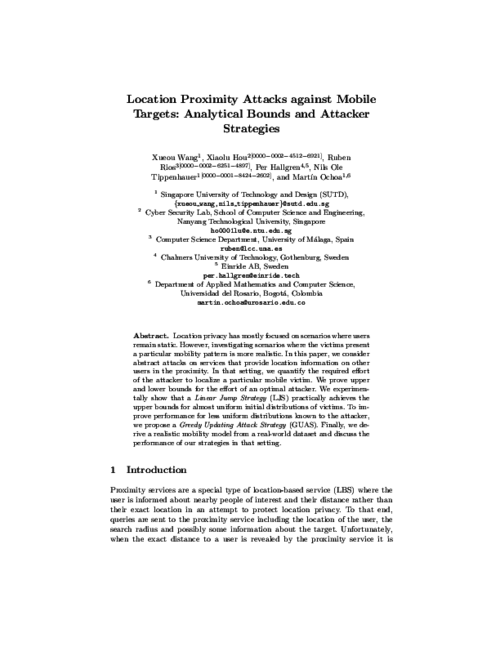
ACM Transactions on Privacy and Security (TOPS), vol. 25, issue 2, no. 10, Association for Computer Machinery (ACM), pp. 1 - 29, 05/2022. DOI
Abstract
Proximity attacks allow an adversary to uncover the location of a victim by repeatedly issuing queries with fake location data. These attacks have been mostly studied in scenarios where victims remain static and there are no constraints that limit the actions of the attacker. In such a setting, it is not difficult for the attacker to locate a particular victim and quantifying the effort for doing so is straightforward. However, it is far more realistic to consider scenarios where potential victims present a particular mobility pattern. In this paper, we consider abstract (constrained and unconstrained) attacks on services that provide location information on other users in the proximity. We derive strategies for constrained and unconstrained attackers, and show that when unconstrained they can practically achieve success with theoretically optimal effort. We then propose a simple yet effective constraint that may be employed by a proximity service (for example, running in the cloud or using a suitable two-party protocol) as countermeasure to increase the effort for the attacker several orders of magnitude both in simulated and real-world cases.
